When selecting roofing materials, think about Asphalt for affordability and easy installation, or Metal for exceptional durability and energy efficiency. Tile offers elegance but requires careful maintenance, while Slate is stylish and weather-resistant. Wood Shake gives a timeless look but demands periodic upkeep. Explore modern choices like Synthetic, Clay, or Concrete for durability and style. For sustainable options, Green Roofs are cost-efficient and eco-friendly, while Solar Roofs reduce energy costs and carbon footprint. Each material has unique benefits and factors to take into account for your home's needs.
Asphalt Roofing
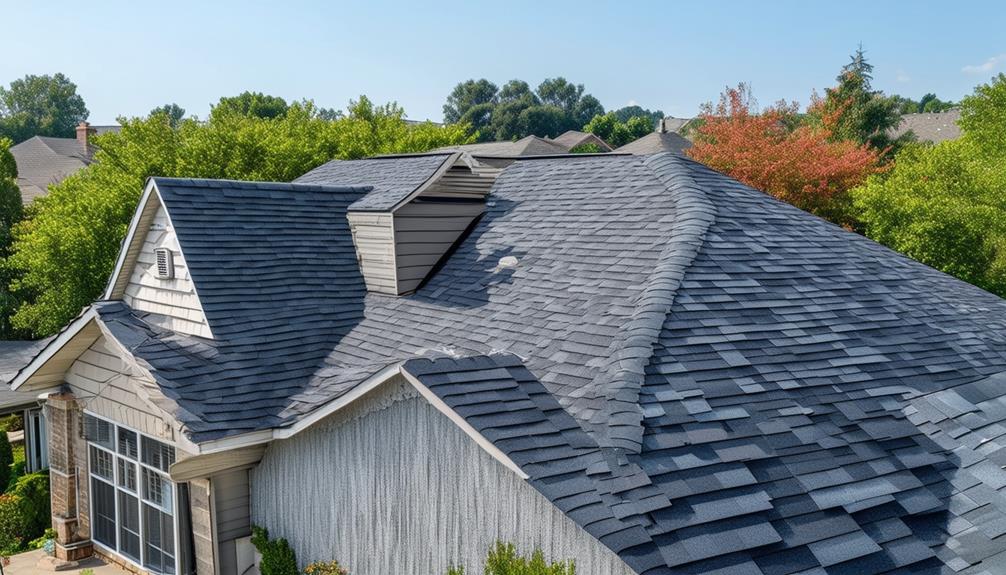
When considering roofing materials, asphalt shingles stand out as a popular choice due to their affordability and durability. The installation process for asphalt shingles is relatively straightforward, making it a cost-effective option compared to other roofing materials. When it comes to cost comparison, asphalt shingles are one of the most budget-friendly options available, making them an attractive choice for many homeowners.
Additionally, asphalt shingles have low maintenance requirements, requiring only occasional inspections and minor repairs over their lifespan. An analysis of lifespan shows that asphalt shingles can last anywhere from 15 to 30 years, depending on the quality of the shingles and the climate in which they are installed. With proper care and maintenance, asphalt shingles can provide reliable protection for your home for many years to come.
Metal Roofing
Metal roofing is known for its exceptional durability, standing strong against harsh weather conditions and lasting for decades. Additionally, metal roofs are highly energy-efficient, reflecting sunlight and reducing cooling costs in hot climates. These points make metal roofing a practical and sustainable choice for long-term protection and energy savings for your home.
Durability of Metal
The longevity of metal roofing is a key factor that distinguishes it from other roofing materials. Metal roofs are renowned for their exceptional durability, requiring minimal long-term maintenance compared to traditional roofing options. This durability is primarily attributed to the inherent strength of metal, making it highly resistant to harsh weather conditions.
Metal roofs are designed to withstand extreme weather elements such as heavy rain, snow, strong winds, and even hail. Their weather resistance properties guarantee that they maintain their structural integrity over time, reducing the need for frequent repairs or replacements. With proper installation and maintenance, a metal roof can last 50 years or more, outlasting many other roofing materials.
Moreover, metal roofs are less susceptible to damage from pests, mold, and rot, further enhancing their durability. Investing in a metal roof not only provides long-term protection for your home but also offers peace of mind knowing that your roof can withstand the test of time and nature's elements.
Energy-Efficient Properties
With their exceptional durability, metal roofs also offer notable energy-efficient properties that contribute to their overall value and effectiveness as a roofing material. Metal roofs are considered one of the most cost-effective options due to their ability to reflect solar heat, reducing cooling costs in the summer and helping to insulate during colder months. This energy-efficient feature can lead to significant long-term savings on energy bills. Additionally, metal roofing is environmentally friendly as it is often made from recycled materials and can be recycled again at the end of its long lifespan. The installation process for metal roofing is relatively straightforward, and once installed, it requires minimal maintenance, further adding to its cost-effectiveness. The reflective properties of metal roofing also help reduce urban heat island effect, making it a sustainable choice for both residential and commercial buildings. Overall, the energy-efficient properties of metal roofing make it a smart and eco-conscious investment for any property owner.
Tile Roofing
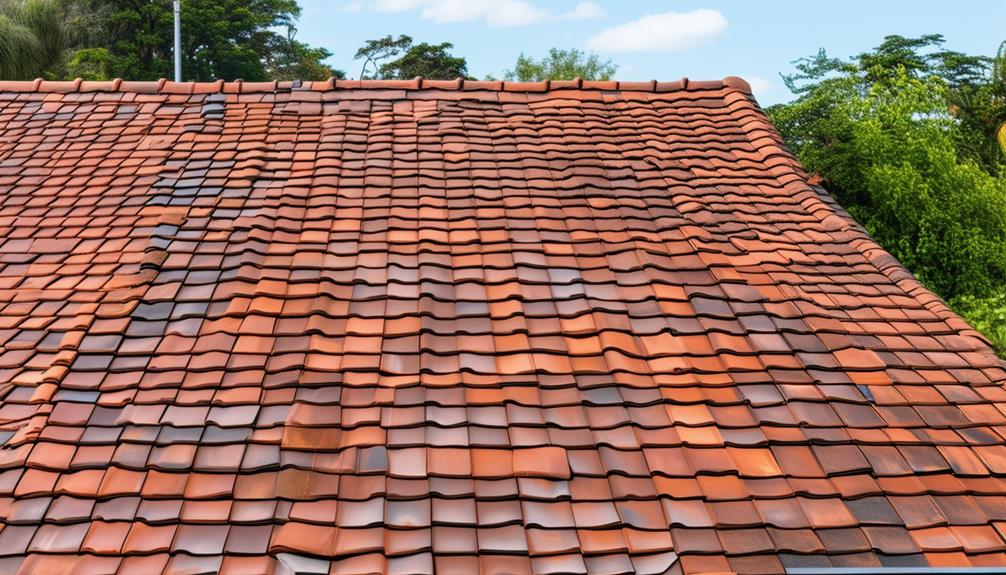
When considering tile roofing options for your home, it is important to understand the benefits and drawbacks of this durable material. Tile roofing offers a classic and elegant look that can enhance the curb appeal of your property. The installation process for tile roofing involves careful placement and securing of each tile, which can be labor-intensive but results in a long-lasting roof. It is essential to verify that the underlying structure of your roof can support the weight of the tiles during the installation process.
In terms of maintenance tips, regularly inspecting for cracked or broken tiles and replacing them promptly is vital to prevent leaks and maintain the integrity of the roof. While tile roofing can be more expensive upfront compared to other roofing materials, its longevity and durability can make it a cost-effective choice in the long run. Additionally, tile roofing is known for its eco-friendly properties as it is often made from natural materials like clay or concrete, reducing its environmental impact compared to synthetic alternatives.
Slate Roofing
Considering the durability and elegance of tile roofing, another excellent option to explore for your home's roof is slate roofing. Slate roofing is renowned for its longevity and classic appearance. The installation process for slate roofing involves careful placement of the heavy, natural stone tiles, which can be labor-intensive but guarantees a beautiful and long-lasting result.
When it comes to maintenance requirements, slate roofing is relatively low-maintenance compared to other roofing materials. As for cost considerations, while the initial investment for slate roofing is higher due to the quality of materials and labor involved in installation, its exceptional durability often makes it a cost-effective choice in the long run.
One of the standout features of slate roofing is its exceptional weather resistance. Slate tiles are highly resistant to harsh weather conditions, including heavy rain, snow, and strong winds. This weather durability adds to the overall value and longevity of a slate roof, making it a popular choice for homeowners looking for a dependable and aesthetically pleasing roofing option.
Wood Shake Roofing
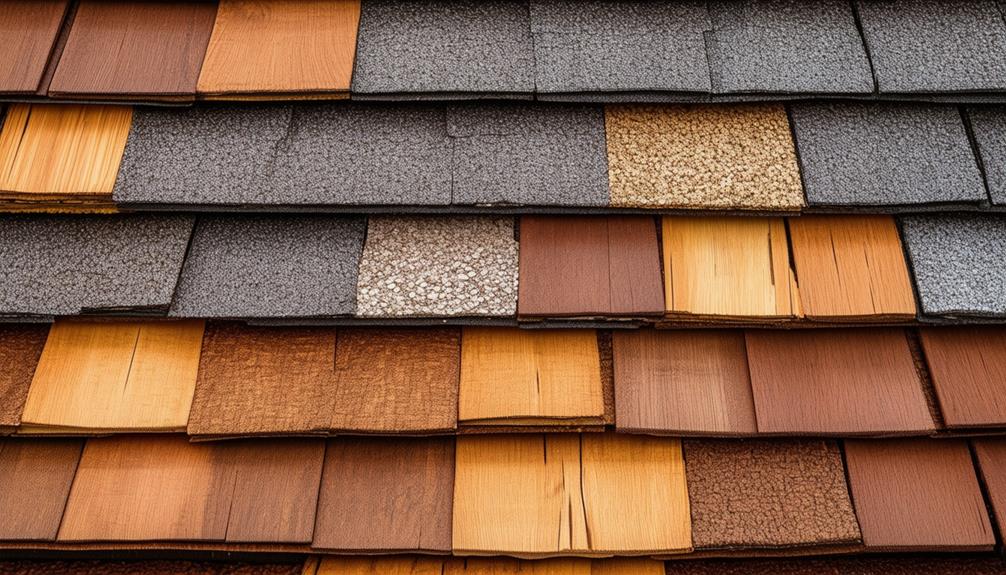
Exploring a rustic and natural roofing option, wood shake roofing offers a timeless charm and distinctive aesthetic for your home. The installation process for wood shake roofing involves skilled professionals laying wooden shingles over a waterproof underlayment, creating a beautiful and durable roof. Maintenance requirements include periodic inspections for damaged or loose shakes, as well as cleaning to prevent moss or mildew growth.
Wood shake roofing provides a warm and inviting look to a house, with its natural wood grain and varying tones adding character and uniqueness. The environmental impact of wood shake roofing is positive, as wood is a renewable resource and can often be recycled or repurposed.
When considering wood shake roofing, remember that regular maintenance is essential to maintain its longevity and performance. By investing in this type of roofing, you not only enhance the visual appeal of your home but also contribute to sustainable building practices.
Synthetic Roofing
For a durable and low-maintenance roofing option that replicates the look of natural materials, synthetic roofing provides an excellent alternative for homeowners seeking longevity and aesthetic appeal. One of the key benefits of synthetic roofing is its exceptional durability. Most synthetic materials are designed to withstand harsh weather conditions, resist mold and algae growth, and have a longer lifespan compared to traditional roofing materials.
Another advantage of synthetic roofing is its low maintenance requirements. Synthetic roofs typically do not require frequent repairs or treatments, saving homeowners time and money in the long run. Additionally, synthetic roofing comes in a variety of styles and colors, allowing homeowners to achieve the desired look for their homes without sacrificing performance.
When considering the installation of synthetic roofing, it is important to hire experienced professionals. Proper installation is vital for ensuring the longevity and effectiveness of synthetic roofing. Additionally, homeowners should inquire about warranties offered by manufacturers to protect their investment in synthetic roofing.
Clay Roofing
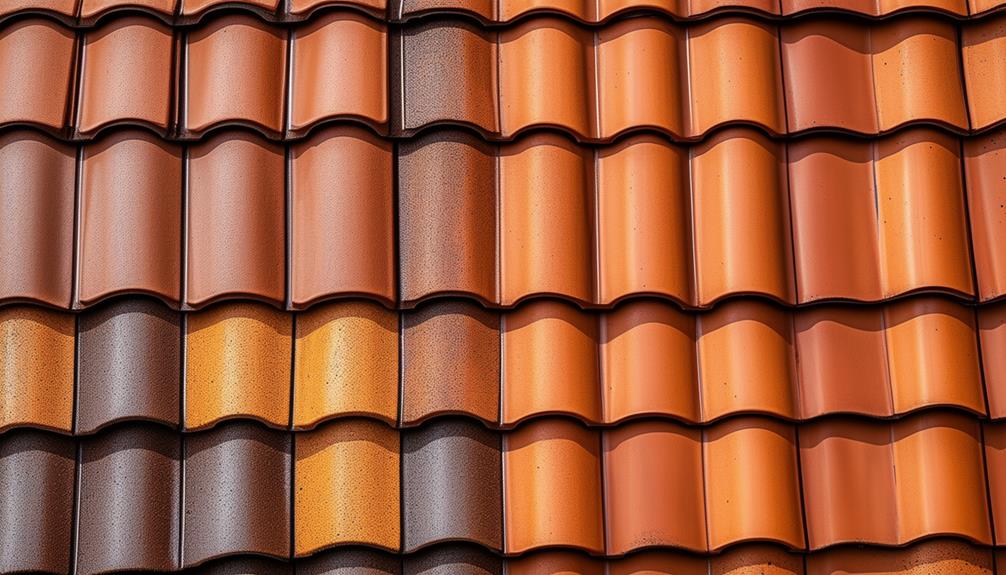
When selecting a roofing material with a timeless and elegant aesthetic, clay roofing stands out as a durable and visually striking option.
- Installation Process: Clay roofing requires a specific installation process due to its weight and fragility. It involves skilled professionals who understand the intricacies of securing clay tiles properly to guarantee longevity and structural integrity.
- Maintenance Requirements: While clay roofing is known for its longevity, it does require regular upkeep to keep it in peak condition. Periodic inspections for cracked or loose tiles, as well as ensuring proper drainage to prevent water accumulation, are essential to prolonging the lifespan of a clay roof.
- Cost Comparison, Environmental Impact: When it comes to cost, clay roofing tends to be more expensive upfront compared to some other roofing materials. However, its longevity and durability often make it a cost-effective choice in the long run. Additionally, clay is a natural material that is eco-friendly and sustainable, making it a desirable option for environmentally conscious homeowners.
Concrete Roofing
With its durability and versatility, concrete roofing presents a reliable option for homeowners seeking a robust and long-lasting roofing material. Concrete roofs are known for their strength and ability to withstand harsh weather conditions. The installation process for concrete roofing involves laying concrete tiles or panels over a roof deck, which can be a bit labor-intensive but results in a highly durable roof that can last for decades with proper maintenance. Additionally, concrete roofing provides excellent thermal insulation, helping to regulate indoor temperatures and improve energy efficiency. While its weight may require reinforced structural support, this robust material minimizes common roofing problems and their solutions often involve straightforward maintenance, such as sealing small cracks or replacing individual tiles. With its combination of longevity and resilience, concrete roofing remains a popular choice for both residential and commercial buildings.
In terms of maintenance requirements, concrete roofing is relatively low-maintenance compared to other materials. Periodic inspections for cracks or damage are recommended, and any necessary repairs should be addressed promptly to prevent water leakage.
When it comes to cost comparison, concrete roofing tends to fall in the mid-range of roofing materials. While it may have a higher upfront cost than asphalt shingles, its longevity can make it a cost-effective choice in the long run. Additionally, concrete roofing has a positive environmental impact as it is recyclable and offers good insulation properties, reducing energy consumption for heating and cooling.
Green Roofing
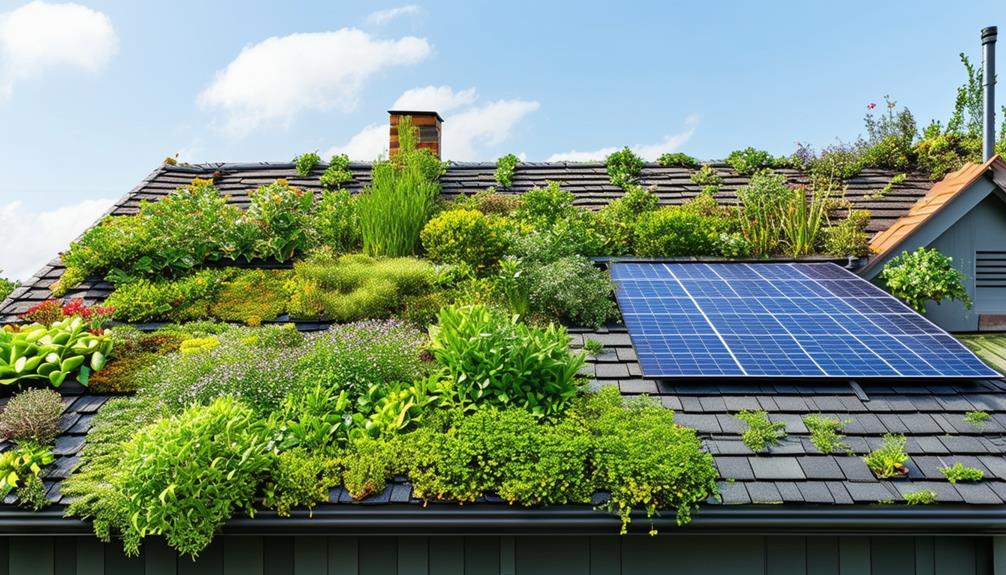
Concrete roofing offers durability and longevity, and now let's explore the eco-friendly option of green roofing. Green roofing provides various environmental benefits, such as reducing urban heat island effect, improving air quality, and promoting biodiversity.
When considering green roofing, the installation process involves adding a waterproof membrane, a root barrier, a drainage layer, a growing medium, and finally, the plants. The layers work together to create a sustainable and efficient roofing system that benefits both your property and the environment. These components not only enhance the building’s insulation and energy efficiency but also contribute to stormwater management by reducing runoff. To ensure a successful project, it’s essential to research roof installation tips and techniques that suit your specific climate and structural requirements. Proper planning and expert guidance can help extend the lifespan of your green roof while maximizing its environmental and aesthetic benefits.
Additionally, green roofing can be cost-efficient in the long run. While the initial installation cost may be higher compared to traditional roofing materials, the energy savings and extended lifespan of the roof can result in significant cost savings over time.
In terms of maintenance requirements, green roofs generally require regular inspections, weeding, and irrigation to make sure the plants remain healthy and the roof functions at its best. Proper maintenance is key to maximizing the lifespan and benefits of your green roof.
Solar Roofing
Installing solar roofing panels on your roof can greatly decrease your energy costs while harnessing renewable energy from the sun. When considering solar panel installation, conducting a cost analysis is crucial to determine the upfront investment versus long-term savings. The initial expense can vary based on factors like the size of your roof and the efficiency of the panels, but many homeowners find that the savings on utility bills over time make it a financially wise decision.
Apart from the cost benefits, solar roofing also has a positive environmental impact by reducing your carbon footprint and reliance on non-renewable energy sources. By generating electricity from sunlight, you contribute to a greener future and may even be eligible for tax incentives or rebates for using renewable energy.
In terms of maintenance requirements, solar panels are generally low maintenance, requiring occasional cleaning to ensure efficient performance. Inspecting the panels for debris or damage periodically can help prolong their lifespan and performance. With proper care, solar roofing can be a sustainable and cost-effective solution for your energy needs.
Frequently Asked Questions
Can Roofing Materials Affect the Energy Efficiency of a Home?
Roofing materials can greatly impact your home's energy efficiency. By choosing the right materials, you can enjoy energy savings and insulation benefits. Certain materials like metal roofs reflect sunlight, reducing heat absorption and cooling costs. Alternatively, materials with poor insulation properties can lead to energy loss and higher utility bills. Consider how roofing materials affect your home's energy efficiency to make a smart choice for long-term savings and comfort. Additionally, energyefficient roofing materials can contribute to a more sustainable lifestyle by reducing your home’s overall carbon footprint. Options like cool roofs or tiles with high thermal resistance are designed to optimize insulation while keeping indoor temperatures stable. Investing in energyefficient roofing materials not only enhances comfort but also adds long-term value to your property.
Are There Any Eco-Friendly Options for Roofing Materials?
When it comes to eco-friendly roofing materials, you're in luck. Sustainable options and green roofing alternatives have blossomed like a garden in spring. From solar panels to cool roofs made of reflective materials, the market offers various choices that not only benefit the environment but also enhance your home's energy efficiency. Embrace these eco-conscious options and watch your roof become a beacon of sustainability in your neighborhood. These advancements in future roofing technology innovations promise even greater possibilities for creating energy-efficient and environmentally friendly homes. Emerging materials, such as solar-integrated shingles and recycled composite roofing, are setting new standards in sustainability. By investing in these cutting-edge solutions, homeowners can stay ahead of the curve while significantly reducing their carbon footprint. Additionally, choosing these advanced materials can add long-term value to your home while reducing maintenance costs. For homeowners planning a roof replacement stepbystep, incorporating eco-friendly options like solar-integrated shingles or recycled materials not only ensures durability but also supports a greener future. By making informed decisions during the replacement process, you can transform your roof into a cornerstone of environmental responsibility.
How Do Different Roofing Materials Impact Home Resale Value?
When considering how various roofing materials impact home resale value, it's important to weigh the cost implications and aesthetic appeal. Different materials can have varying effects on the perceived value of your home. For example, high-quality materials like slate or metal might increase the resale value due to their durability and upscale look, while more common materials like asphalt shingles may have a more moderate impact on resale value.
What Maintenance Is Required for Various Types of Roofing Materials?
To keep your roof in top shape, regular maintenance is essential. Different roofing materials have varying durability levels and costs. For instance, asphalt shingles are affordable but may need more frequent repairs compared to metal roofs, which last longer. Make sure to inspect for any damage, clean gutters, and trim overhanging branches. Investing in periodic inspections and repairs can extend the lifespan of your roof and save you money in the long run.
Are There Any Roofing Materials Suitable for Extreme Weather Conditions?
When it comes to extreme weather conditions, you need roofing materials that can stand strong. Look for snow resistant roofing if you face heavy snowfall, or hurricane proof roofing for areas prone to strong winds. In tropical climates, opt for materials that can handle high humidity and heat, while in Arctic weather, choose roofing that can withstand freezing temperatures. Consider the climate carefully when selecting the right roofing materials for your home.
Conclusion
To sum up, when selecting roofing materials, take into account the durability, aesthetics, and environmental impact. While some may argue that certain materials are more expensive upfront, keep in mind that investing in high-quality roofing can save you money in the long run through energy efficiency and longevity. Picture a beautiful tile roof safeguarding your home for generations to come, adding value and curb appeal. Choose wisely and relish the benefits of a well-constructed roof.




